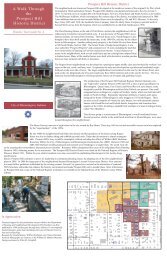Peak Oil Task Force Report - City of Bloomington - State of Indiana
Peak Oil Task Force Report - City of Bloomington - State of Indiana
Peak Oil Task Force Report - City of Bloomington - State of Indiana
You also want an ePaper? Increase the reach of your titles
YUMPU automatically turns print PDFs into web optimized ePapers that Google loves.
The Fourth Layer: Pr<strong>of</strong>essional Care in Centralized Locations<br />
The fourth layer <strong>of</strong> care in a restructured system would consist <strong>of</strong> what is <strong>of</strong>ten the first line<br />
<strong>of</strong> medical attention today: the provision <strong>of</strong> services by pr<strong>of</strong>essionals in a centralized<br />
hospital or clinic. Hospitals will need to revise their equipment and organization to<br />
respond to shortages <strong>of</strong> disposable supplies and pharmaceuticals (which derive from oil),<br />
the inability <strong>of</strong> employees to commute as frequently, or as far, and even to the possibility <strong>of</strong><br />
regular power interruptions.<br />
The Fifth Layer: Palliative, Nursing & Maintenance Care<br />
A fifth layer <strong>of</strong> care, which exists today primarily in the hospice setting, would be an<br />
expansion <strong>of</strong> palliative, nursing, or maintenance care for those individuals at the end <strong>of</strong> life<br />
or whose conditions are either not responsive to medical intervention, or for whom the<br />
choice <strong>of</strong> medical manipulation is unwelcome. It's quite within the realm <strong>of</strong> imagination<br />
that proper medical care, even for patients whose conditions can heal, might lie in<br />
providing supportive care and guidance outside either home or hospital, as in a spa or<br />
sanitorium, where time and retraining in new personal health practices could result in the<br />
reversal or remission <strong>of</strong> illness. 246<br />
Some elements <strong>of</strong> this layered care system exist today, though arguably the first and most<br />
important <strong>of</strong> these is the weakest, and is under constant assault by commercial interests. A<br />
layered approach to health is most effective when all the elements in it are integrated and<br />
mutually reinforcing. Regrettably, the current medical model is poorly equipped to suture<br />
the layers <strong>of</strong> health together as conceived above. As citizens, as consumers <strong>of</strong> medical<br />
services, and as individuals and families concerned with our own well‐being, we will have<br />
to demand more holistic thinking from everyone about the sources and pathways to health.<br />
With costs lowered by structural reorganization and new thinking, it might be possible to<br />
implement community scale health coverage for all, regardless <strong>of</strong> what does or does not<br />
come about from federal action.<br />
246 Thanks to Dr. Jifunza Wright, M.D. <strong>of</strong> Chicago, Illinois for suggestions contributing to the new model <strong>of</strong><br />
care.<br />
<strong>Report</strong> <strong>of</strong> the <strong>Bloomington</strong> <strong>Peak</strong> <strong>Oil</strong> <strong>Task</strong> <strong>Force</strong> 210









